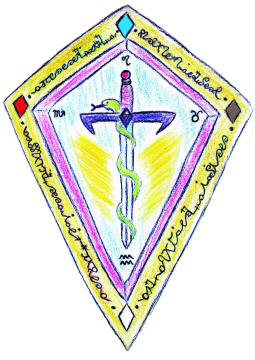
Resources of the Fire Realms
Resources of the Fire Realms

02. Billy Idol - Catch My Fall

03. Simple Minds - Glittering Prize
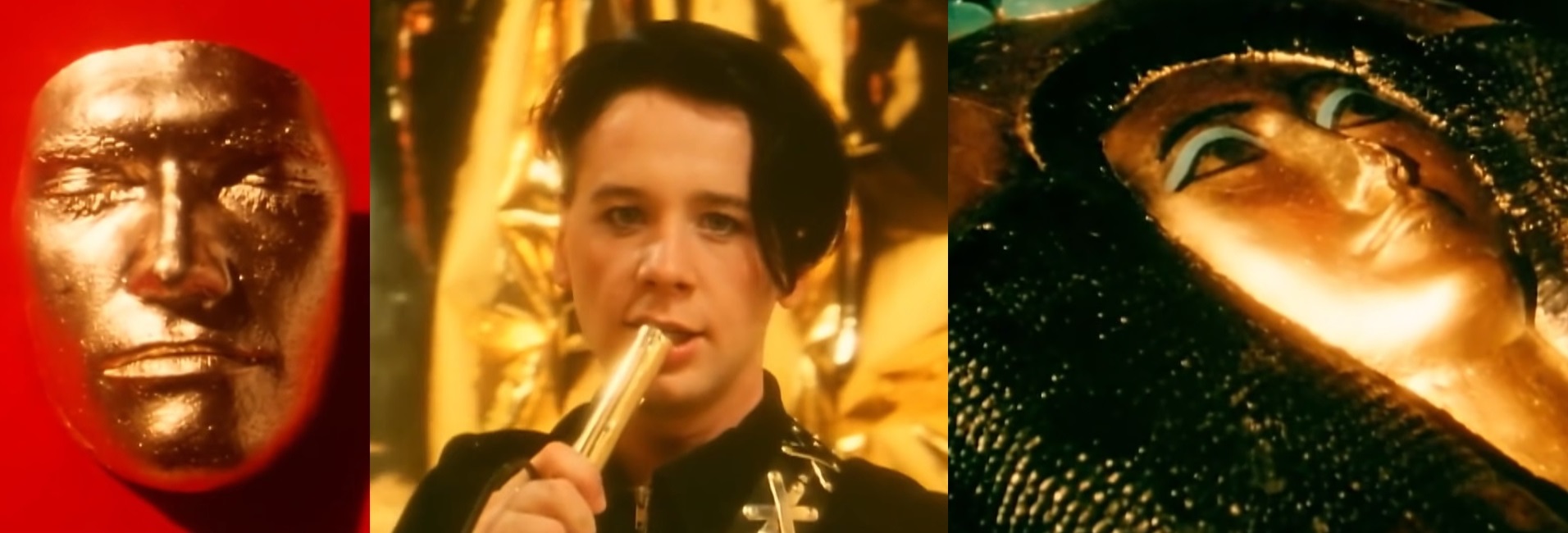
SONGS OF THE FIRE REALMS
02. Led Zeppelin - Kashmir
03. Scars on Broadway - Hungry Ghost
04. Robert Plant - Carry Fire
05. Noël & Jeremy - Desert Sun
06. Billy Idol - Man For All Seasons
Contents
#1. Cupid and Psyche
#2. Cadmus and Ogma
#3. Pan and the Nymphs
#4. Hercules
#5. The Golden Fleece and Dragons
#6. Hero and Leander
#7. Apollo and Daphne
#8. Circe
#9, 10, & 11. Perseus, Andromeda, and the Gorgon's Head
#12. Floris and Blancheflour
#13. The Cave of the Nymphs and Olive Trees
#14. Sand Fairies
#15. Tristram of Lyonesse
#16. Echo and Narcissus
#17. Diana, Actaeon, and the Horned God
#18. The Sibyl and Infernal Regions
BOOKS
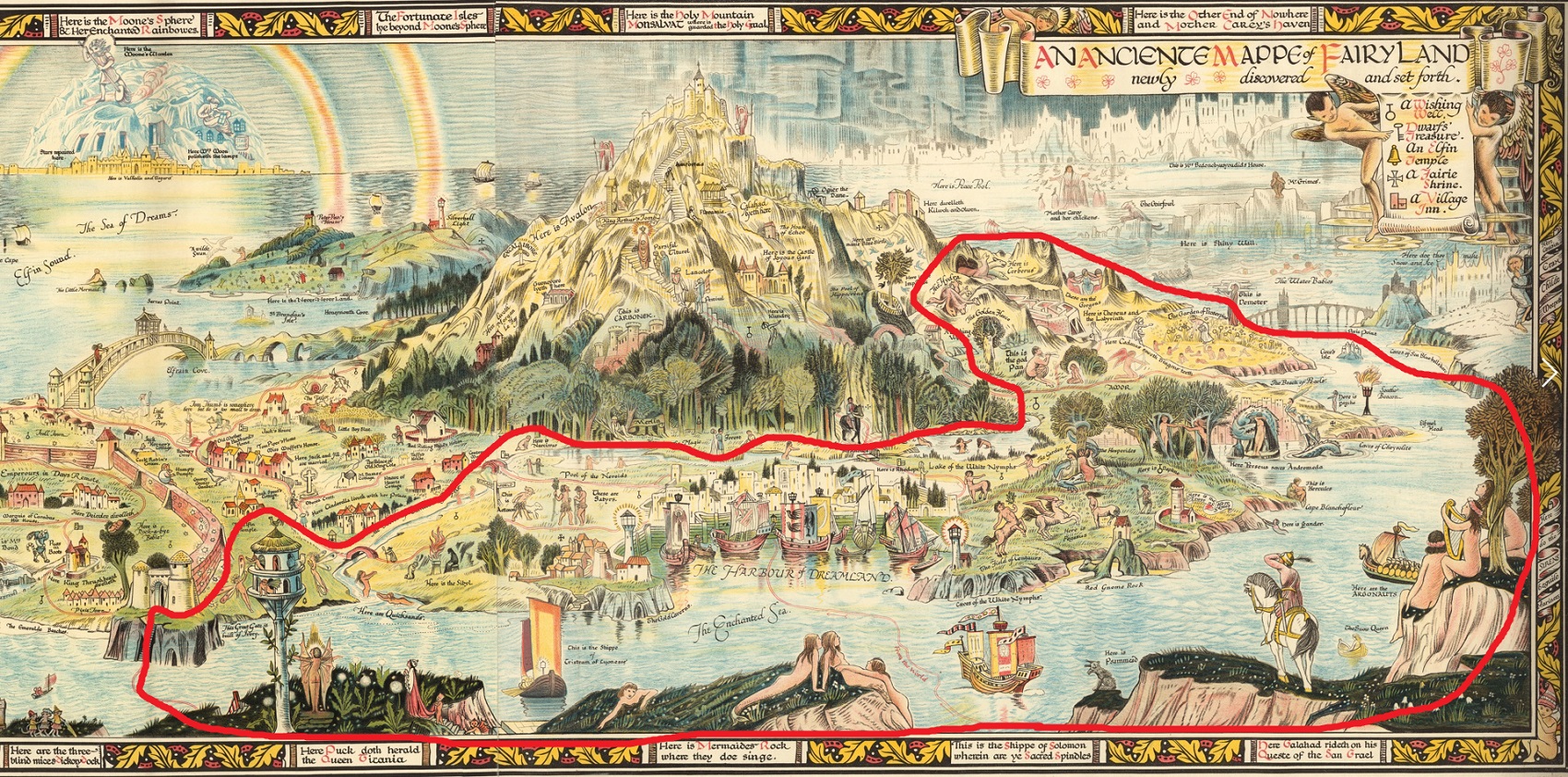
For example, towards the bottom right corner - near the ship, is a little creature sitting on a rock called the "Psammead".


"Here in the Land of Fire, the ocean speaks its own language and brings gifts to the people. It laughs and plays and dances and it greatly enjoys interacting with the inhabitants of the land who I now see are gathering all around the little pools, searching for gems and prizes. The wizard tells me that every dawn, and periodically throughout different times of the day, the waves bring the inhabitants great gifts, and each day it is a surprise to them what they might find next." - Page 5, Book of Fire - Vol. I, Jeremy Garner.
In both cases we have descriptions of people going down to the seashore to gather different wishes/gifts of that day, especially during the hours of the early morning or dawn.
Though I did not personally yet see any sand-fairies when I was there - it was certainly evident that people received their wishes from this area during the early hours especially.
I was also of course in the Land of Fire which is connected to sand, deserts, and so forth.
This is a clear example of how the creatures found in the Southern Realms of Sleigh's Map - are especially connected with the properties and conditions of the Fire World - and can in this way provide clues to us of the nature of these realities. By then reading the books - we open up a world of information about the inhabitants found within those hidden locations.
In this way, he has provided not only a surface-level map - but one which corresponds in perfect order to a great variety of myths, legends, and fairy stories - all of which provide deeper information and keys for uncovering the deeper mysteries of these locations.
To familiarize yourself with the inhabitants and locations found within the Fire Realms, it is recommended to first read the stories which correspond to that particular area of the map.
For ease I have listed them below with free links to find this precious treasure trove of books but keep in mind that
Book #1.

There is also much reference to passion, sex, love, pleasure, and the mysteries of death, rebirth, hidden paradises, and the underworld - all of which have many connections to the Fire Realms (which contains the entrance to the Underworld).
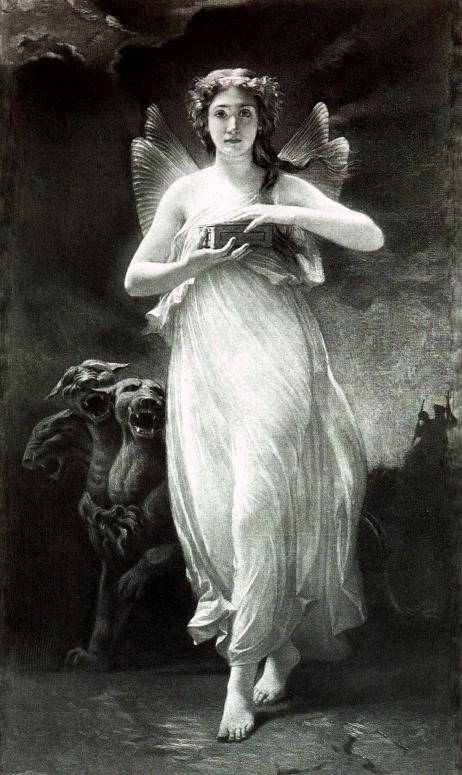
Consider also the lines of T. . Harvey: "They wove bright fables in the days of old, when reason borrowed fancy's painted wings; when
Proserpine or Persephene (like Cupid and Psyche) is also interchangeable between both the Fire and Air Realms, specifically traveling between both of these at different seasons. She carries deeper connections with the sirens who can also be seen somewhat nearby the same area on the map. She can be read about in more detail in Chapter VII of the same book.
In regards to Proserpine, Bulfinch explains that "Proserpine signifies the seed-corn which when cast into the ground lies there concealed—that is, she is carried off by the god of the underworld. It reappears—that is, Proserpine is restored to her mother. Spring leads her back to the light of day." - this explanation providing us again here with another example of cocoon-like death, the underworld, and transformation through the path of love which ultimately guides us to the rebirth of spring through which we can enter renewed into Faerieland (the Air World).
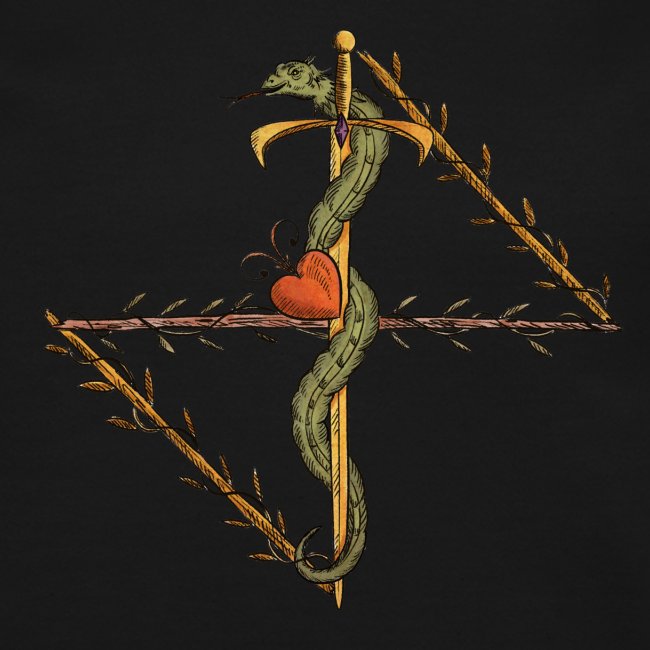
Book #2. Chapter XII. Cadmus
Interestingly, Cadmus is said to have introduced writing, letters, and an alphabet into Greece. This first alphabet was said to have consisted of sixteen letters. Ogma has been described by some as the "Cadmus of the Celts" because he is attributed with the Ogham Alphabet.
I suggest that the reason for Cadmus's inclusion in the Fire World is due to the association that this world has with alphabets, languages, and letters.
Thoth who has been connected to Hermes is also said to have brought writing/alphabets to the Ancient Egyptians - and Hermes can also be found in the Fire Realms (though he is found at the border between Fire and Air, and can very easily travel between any of these worlds).



Serpents are heavily connected to the Fire Worlds (where the Jinn can also take their form) and Faerieland in general (hence the serpent on the faerie emblem - and the two serpents on the Caduceus Staff of Hermes). We are reminded here of the sacred AURYN spoken of in The Neverending Story, which is also said to have been a magical necklace with a light and dark serpent - each of them biting the others tail.
Cadmus's wife Harmonia was given a similar style necklace from Hephaestus (Vulcan), who is known as the God of Fire - as well as metal work, crafts, etc. He is not dissimilar to Tolkien's depictions of the Valar "Aulë", who created the dwarfs.
When Cadmus sowed the teeth of the dragon in the ground - they eventually came up from the earth as beings with helmets, armor and so forth - and battled the other earth-born ones until there were just a few of them left. These joined with Cadmus to build the city of Thebes.
When Harmonia's necklace (made by Hephaestus) was stolen - the son of the thief's lover went mad and killed everyone in the house by setting it on fire. This is the last mention of the necklace (beginning and ending(?) in fire) so that it is not yet known if it survived the flames.
Book #3. Chapter IV. Juno and Her Rivals
In the story, Pan is chasing a nymph by the name of Syrinx in an attempt to have her, but she escapes his advances by calling on her water nymph friends at the bank of a river. Thus, just as Pan was about to overtake her and he threw his arms about what he thought was her - it became evident that he had instead laid his arms around the river reeds. Breathing a sigh, it went through the reeds and produced a melodious sound - and charmed with their sound he sufficed himself with creating reed pipes in honor to the nymph, since he could not have her.
"The winds of GOD’S heaven that over them blow,
Shall presently wake them to music again,
May be of gladness, or may be of woe!"
- River Reeds, Anna Kingsford
I describe my experience with these Water Nymphs in "The Book of Fire - Vol. I", describing them as very beautiful, playful, flirtatious, and flower-crowned.
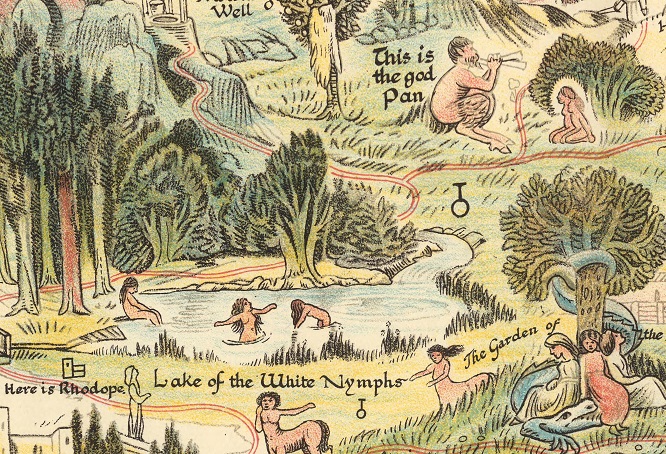

It is also of significance to fire due to the manner in which Hercules "died" from the earth. The story explains how he built a funeral pile of trees (after unintentionally wearing a very agonizing blood-soaked and poison garment which burned at his flesh), and he laid himself down on the pile of trees and ordered to be set up in flames.
Jupiter explains in the book: "Fear not. He who conquered all else is not to be conquered by those flames which you see blazing on Mount Oeta. Only his mother's share in him can perish; what he derived from me is immortal."
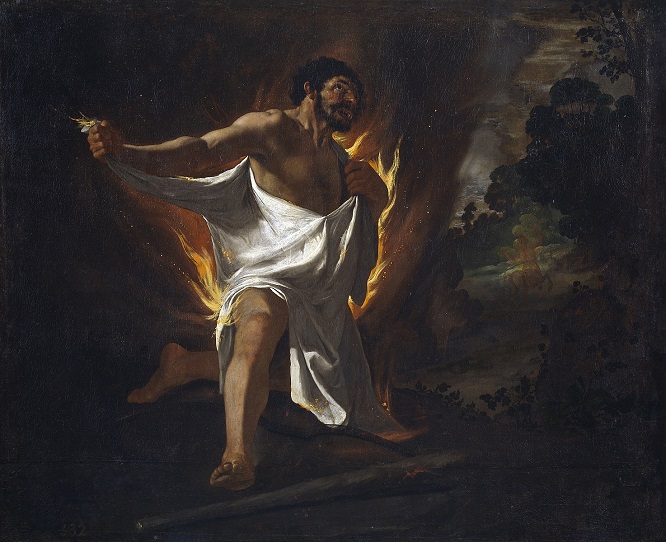
Book #5. Chapter XVII. The Golden Fleece
The Golden Fleece on the other hand was also on a ram which had flying powers. The ram was eventually sacrificed and the golden fleece put under watch by a sleepless dragon and two fire-breathing bulls with brazen feet. It was the Argonauts who went in search of this dragon in the hopes to reclaim the golden fleece. Hercules is said to have been among them. Their ship is also near to him on the faerie map.
The quest of the Argonauts for the Golden Fleece is also mentioned in the "Salamanders and Dragons" section of my "Book of Fire - Vol. I" where I mention them in connection with the Ljubljana Marshes. On their return from the quest for the golden fleece, the argonauts find a lake surrounded by marsh lands between the present-day towns of Vrhnika and Ljubljana. There were other marsh lands I had explored in the Fire Realms - and I later discovered that this city of Slovenia (Ljubljana) does indeed have great histories and symbolism related to the existence of dragons. There is too much on this to go into here, but the Book of Fire explains.
Also of great interest here is the fact that on their way to find the fleece - the argonauts meet a mysterious sage by the name of "Phineus", who instructs them as to their future course and teaches them how to safely pass the crashing rocks. His name is pronounced identically to the Irish name associated with these Fire Realms, being "Findias" or sometimes "Finias".
"What became of the fleece afterwards we do not know, but perhaps it was found after all..." - T.B.

Book #6. Chapter XIII. Hero and Leander
We see this depicted in the Fire Realms on the same island where Ogma/Hercules is, which is of course very near to the ocean. The fire symbolism can be seen in the torch / light-house that was found in the Tower where Hero of Sestos lived. We see here the symbolism of passion, love, fire, and death / the after-life which are deeply connected with the Fire Realms.
"Swimming the Hellespont was looked upon as fabulous, and the feat considered impossible, till Lord Byron proved its possibility by performing it himself." - Thomas Bulfinch
It was called the "Hellespont" due to the woman "Helle" in Greek mythology who fell from the flying golden ram (described in the previous "Golden Fleece") into the strait or "Sea of Helle" which was named after her. Phrixus (the twin brother of Helle) survived though all the way to Colchis, where the king took him in and gave him his daughter in marriage - and so Phrixus offered him the golden fleece in return.
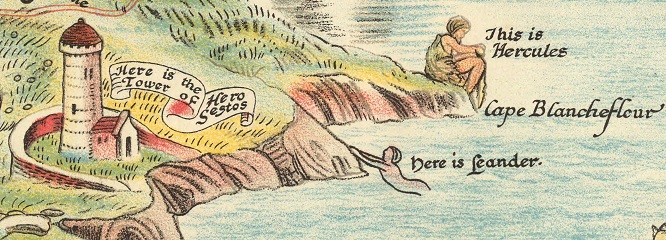
Hugh Mynne explains it thus: "Brigid, one of the primary aspects of the Faerie Goddess, presides over the hearth-fire, the center and focus of every home. She is thus "the mothering fire in the midst of the house," whose outstretched hands take our hands, sheltering and warming us in the depths of winter. However, as the patron of smithery, She also holds the secrets of furnace and forge—the secrets of the red-hot vessel of transmutation, in which the sword (the sword of the spirit, we might say also) is heated and ruthlessly tempered. Brigid's hearth-fire can thus be seen as the entrance to the blazing and transformative world of the inner earth or underworld, the furnace/ womb of the Earth Mother Herself. In Scandinavian/German mythology, this is the realm of the Goddess Hel. Our word "Hell" is derived from Her name. Yet Hel, as well as being Queen
of the Underworld, rules as Faerie Queen of Summerland. We come full circle to the light again—the true meaning of Hel's name is "light," that light within the Earth that the Faerie initiate seeks to experience and mediate."
And so it is interesting that the story of Leander and Hero, and that of the Golden Fleece - both reference the name "Helle" and are seen here in the Fire Realms which many have thought to be a place of torment or fear due to Christianity. Instead we find a place of light and transformation that has the potential to lead us into great realms of hidden paradises.
Byron wrote: "The winds are high on Helle's wave, as on that night of stormiest water, when Love, who sent, forgot to save, the young, the beautiful, the brave, the lonely hope of Sestos' daughter. O, when alone along the sky, the turret-torch was blazing high..."
Fiona Macleod writes: "In the torch-lit city of Finias that flames on the brow of the South, the Spear that divideth the heart, is held in a brazen mouth..."
Further showing us how Bernard Sleigh has very carefully placed these stories upon the map, to represent certain aspects of the faerie worlds which exist in those locations.
Book #7. Chapter III. Apollo and Daphne
In this story, Apollo pursues the uninterested nymph Daphne - and eventually she too begs to be saved at the last moment before he can catch her, after which she then transforms into a Laurel Tree.
As he cannot have her for his wife, he has the tree - wearing laurel wreaths as his crown, etc. This tree was once known as "Daphne".
Another term for the "laurel" leaves are "bay leaves". These have clear associations with the
The smoke is also particularly magical for relieving one of heartbreak - cleansing the air, and refreshing your mind so that you can start fresh. The leaves produce very clear pictures in a way that is quite uncanny in comparison to the burning of other types of leaves - and these ones will respond (when set alight) to questions that are asked of them (most especially to the one who can sense how to intuitively read the signs and symbols that it vividly provides).
Pliny the Elder purportedly was said to forbid the use of burning the leaves for divination - explaining that the loud crackling that they make was evidence that they do not wish to be burned. I only hope he was not right about this, but I do believe that we should really only use the dried leaves for these purposes and sparingly too. The loud crackling really tends to be a symbol of future success and granting the desired outcomes to what was asked of it, whereas if the sound is quiet it can represent either a negative or more neutral outcome. You can make a wish upon the leaves in this way.
To renew or transform bad energies into good ones, the smoke from the bay leaves is magic. A state of peace and calm - or mild euphoria - can be felt almost instantly upon inhaling the smoke of the leaves. These can also induce trance-states and provide hidden information.
This magical art carries the name of "Daphnomancy" - from "Daphne", being a form of pyromancy (divination by fire).
It is clear then why Bernard Sleigh must have included "Daphne" in the Fire Realms section.
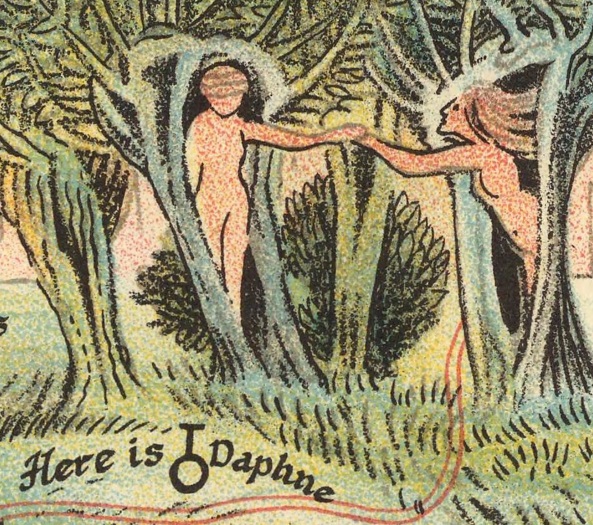
According to the maps key, this symbol represents a "wishing well".
This is because one can wish upon the laurel leaves in the same way I have described above.
"Green spirits hiding in the trees, hold secrets of the light..." - The Tale of Lovers Torn
Book #8. Chapter XXIX. The Laestrygonians
In this story we learn of the enchantress and powerful magician called "Circe" who is also heavily connected with the Fire Realms (being the Daughter of the Sun God Helios).
We see here then another reference to "HEL" or "light", in the name "HELIOS".
All of the findings on this page have been in the Southern Region of the Map of Faerieland - and continue to represent the element of fire/sun/underworld and summer. When we move to the left of the map this journey will continue to East/Spring, West/Water, and North/Earth.
This order of South to East to West to North (SEWN) is a magical formula that I discovered during the authorship of my book "Faerie Magic" - and details are in that book as to how this conclusion was drawn.
Circe transformed men into beasts and swine. More can be seen on this in the chapter itself.


Books #9, 10, and 11. Chapter XV. On Perseus
You can also read all about Perseus (and of the Argonauts, etc, from earlier) in
I first learned of the Gorgon's in Gorias (in the Air/Spring Realms) - but they are depicted on Sleigh's map right next to the Underworld, which makes sense considering that Homer wrote of them as a singular monster of the Underworld (Hesiod wrote of them as three sisters).
In "Age of Fable" we read of Perseus successfully cutting off Medusa's head - whose head turns any who look upon it into stone. He is sent by King Polydectes to this task, who dwelt in Seriphus.
The derivation of this word is unknown, as is the etymology for the word "Seraphim" - though the latter is possible to derive from a word meaning "to burn". The Seraphim for example are said to guard the way to the Garden of Eden with a flaming sword that turns in all directions.
Perseus is later described as winning Andromeda, after rescuing her from a sea monster.

Phineus though hurls his javelin at Perseus - though misses - after which several others begin to attack Perseus.
Perseus then makes friends with his enemy (Medusa), in the sense of using her cut off head to turn his assailants into stone. Phineus perceiving what is happening - eventually falls to his knees (turning his head away so he will not turn to stone) and begs for his life. Perseus only grants him that he shall be preserved in his house as a memorial of these events - then he holds the head to his eyes and turns him into stone.
It is interesting that we have here another example depicted in the Fire World of the Map, where the name "Phineus" (so close to the very name of the Fire World: "Finias") is used (though this is a different being to the seer referred to in the story of the Golden Fleece).
There is a prevailing them of love conquering death - of escaping the fate of turning to stone or being devoured, and instead entering the paradises of love (which will be the "Air World").
Those who find the secret paths within the fire world - conquer it, in the sense of entering the forbidden gardens of eternal youth - wherein one can then discover the "Tree of Life".
"There's an angel on my shoulder, in my hand a sword of gold,
Let me wander in your garden, and the seeds of love I'll sow..."
- Houses of the Holy, Led Zeppelin
Book #12. Floris and Blancheflour
Evidently this book (which I presume is mentioned on the map near Leander and the Tower) - with the words "Cape Blancheflour", appears to also be heavily connected with these same themes of love conquering death - and desert/fire realm content. Blancheflour itself means "white flower" - and it is quite possible that the name of the Fire World being "Findias" stems from "Find" which may mean "bright", "white", or "fair".
There are supposedly references in the story to Blanchefleur being sold to merchants who are traveling on their way to either Cairo or Babylon, where she is then sold to an "amir" (an Arabic term for a prince or leader of sorts). Her lover Floris eventually journeys to seek her.
There is said to be a tower (perhaps why it is also drawn near the Tower of Hero on the map), which houses many maidens who are selected on a yearly basis before killing his last wife. Blancheflour is said to be his next chosen bride. Floris manages to get into the tower in a basket of flowers and reunites with his lover but is apparently later discovered by the amir - who seeks council as to what he should do instead of killing them on the spot. The advisers are apparently so impressed by the willingness of the two to die for one another that they persuade the amir to spare their lives.
If this is indeed the story then we clearly see many references to the Fire World throughout and the conquering again of passionate love over death.
As a side note, the words "Here is Rhodope" on the map (near the water nymphs), is likely placed there due to the fact that this was the name of one of the Oceanids / water-nymphs. She was apparently one of the playmates of Persephone/Proserpine in the meadows of Sicily, when Persephone was abducted by Hades to be his queen in the Underworld.
Book #13. Lines 102 to 112 in Book XIII of The Odyssey
"At the head of the harbor is a long-leafed olive tree, and near it a pleasant, shadowy cave sacred to the nymphs that are called Naiads. Therein are mixing bowls and jars of stone, and there too the bees store honey. And in the cave are long looms of stone, at which the nymphs weave webs of purple dye, a wonder to behold; and therein are also ever-flowing springs. Two doors there are to the cave, one toward the North Wind, by which men go down, but that toward the South Wind is sacred, nor do men enter thereby; it is the way of the immortals."
These lines have been considered so mysterious that entire books have been written about them in an attempt to determine their meaning - such as "On the Cave of the Nymphs" by Thomas Taylor where he explains that "Cronius, says, that
adapted to weaving placed here for the Nymphs ; and these not formed from wood,or any other pliable matter, but from stone, as well as the amphorae and bowls ?
Which last circumstance is, indeed, less obscure ; but that, on these stony beams, the Nymphs should weave purple garments, is not only wonderful to the sight, but also to the auditory sense. For
The details of these mysteries are made a lot clearer in the context of the faerie worlds and the ancient formula I have been alluding to here - with the order of South, to East, to West, to North (SEWN). Most people would perhaps instinctively begin from the Earth and work their way to Heaven (ascent) - whereas those like Prometheus who steal the heavenly fire and bring it downwards to earth take the opposite direction (descent) from heaven to earth.
In my books of Fire, Air, Water, and Earth - I outline the journey I took from the South to the North, this being made by ancient and secret pathways. By doing this, there is in some sense a "fall" that takes place - but one can then rise again after this descent as part of the process.
In terms of the Tarot Cards - this mystery is hidden on the "X. Wheel of Fortune" tarot card which shows the ascending or descending serpent (based on which direction you take) and this cards symbolizes many of the mysteries and directions associated with the faerie worlds. I explain this in great detail within my "Book of Air - Vol. I".
The Summer/Fire direction begins at the letter "A", near the dog head (an "A" upside down), and what appears to be an "arrow" of the compass is also the alchemical symbol for sulphur - thus being representative of the Fire Realms. The symbol by the letter "T" is for Mercury who carries us into the Air world - the symbol by the letter "R" is water, and the symbol by the letter "O" of a circle with a line through it is the alchemical symbol for Salt of the Earth.
ATRO means the black, dark, or more sinister path. Though in darkness is hid much wisdom.

The sacred formula which I discovered, and which I am convinced that Bernard Sleigh also discovered due to how he has carefully crafted his Map of Faerieland - spells out the word "ATRO" on the Wheel of Fortune card and forms the Eihwaz Rune (seen in the image above). Upon completely the journey of this rune through the heart center and back to the South - it forms the Dagaz rune which can appear much like a butterfly or an hourglass - and is a result of the transformation which takes place upon this journey. Much of this will not likely make as much sense right now until it is directly and personally experienced, but all of this is real.
ORTA (being ATRO backwards), non coincidentally means "rise, raise, lift up" in Quenya - Tolkien's Elven language. This is what happens when we raise back up from Earth, to Water, to Air, to Fire - after having first brought the fire down from heaven (united it with those of the earth) and then raised it back to heaven.
“Peace up to heaven.
Heaven down to earth.
Earth beneath heaven,
Strength in each,
A cup very full,
Full of honey;
Mead in abundance.
Summer in Winter...
Peace up to heaven...”
- Caith Maige Tuired
This is accomplished through the secret/ancient and sacred paths of the heart: "AORTA".
The word "Aorta" which refers to the main artery that carries blood from your heart to the rest of the body, may be etymologically connected to the word "aeiro" meaning "to lift", to "raise", to "heave". Greek aorte is a "strap to hang something by". Not unlike the "cross".
Æ writes though that "The turning earthward of that heaven-born power is the sin against the Holy Breath, for that fire which leaps upon us in the ecstasy of contemplation of Deity is the Holy Breath, the power which can carry us from Earth to Heaven.”
He is referring to the one and unforgivable sin against the Holy Spirit alluded to in the Bible. "All manner of sin and blasphemy shall be forgiven unto men: but the blasphemy against the Holy Ghost shall not be forgiven unto men."
Which is likely why he added "It is the Promethean fire, and only by mastery of this power will man be able to ascend to the ancestral Paradise.
Hugh Mynne adds that: "The Faerie Way is indeed a shamanic path, and
Going back to The Cave of the Nymphs, it is evident that the "Olive Tree" mentioned at the "head of the harbor" with a nearby "shadowy cave" - is the very cause of those shadows in the cave - for the Olive Tree is a symbol of Light. In Revelation 11:4 in the Bible we read of the "Two Olive Trees" which are "The Two Lampstands that Stand before the Lord of the Earth".
Olive trees were used as lamp oil (“You shall command the people of Israel that they bring to you pure beaten olive oil for the light, that a lamp may regularly be set up to burn." - Exodus 27) - and they tend to have white/yellow flowers.
It is also an olive branch which the dove returns with after the flood subsides in the story of Noah and the Ark - representing evidence of new life - though initially a dark raven was sent.
The answer to Thomas Taylor's question of "who would believe that Goddesses weave garments in a cave involved in darkness, and on stony beams ; especially while he hears the poet asserting, that the purple webs of the Goddesses were visible?" is quite simply that they were able to see by the light provided from the mysteries of the Olive Tree.
Hence Bernard Sleigh has clearly drawn a lighthouse tower (at the head of the harbor of dreamland), being right beside the two entrances of the "Caves of the White Nymphs".

The sacred path of the south is available through either dreams/trance (these caves are right next to the "Harbour of Dreamland" on the map) or death. But death does not have to be as physical as we thought in order to experience these realities. As Jesus explained: "Truly, truly I tell you that no one can see the kingdom of God, unless they are born again".
"For kingdoms shaken and queens forsaken and
high hopes starved in their drouth,
These are the torches ablaze on the walls of
Finias that lightens the South." - Fiona Macleod
From Psyche and her butterfly wings of love and transformation, to Proserpine returning in Spring to the light of day, to Hercules dying in flame, to Hero and Leander dying for love, to the transformation of Daphne, and the conquering of love over death shown in the story of Perseus and Andromeda - we are seeing a variety keys that lead through the Fire World or Summerland of Death, into the Spring World of Eternal Life and Paradise, being: Faerieland.
This is why "Humpty Dumpty" and "Rock-a-bye-baby" are depicted on or near the wall to the "Air Realm" in the Map of Faerieland - because one cannot enter that sacred realm without first being spiritually born again.

Book #14. Five Children and It
These can also be digitally read here, here, and here.
As was earlier explained - one of the significant aspects of these books to the Fire Realms is due to the Psammead who is a sand fairy.
A continuing theme throughout the entire book "The Phoenix and the Carpet" though is very specifically fire. For example, the whole story begins just before Guy Fawkes Night (which is associated to fireworks, etc) - there are accidental fires caused and the phoenix is born from an egg knocked into the fire. As with Hercules, the Phoenix eventually directs an altar to be built, upon which it is then burned - after laying an egg from which he will later be reborn.
This continues the recurring themes of the Fire Realms being related to death and rebirth.
Book #15. Tristram of Lyonesse
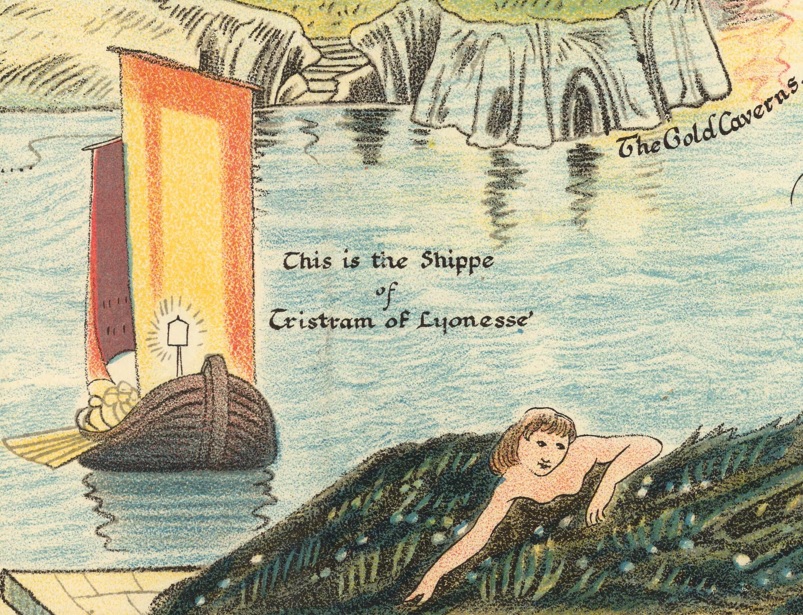
This is just a brief example from many more, but the examples of the themes and concepts of fire continue throughout the entire prelude in a most unmistakable way, speaking about
All of these words are used within the first 8 pages of the book - demonstrating clearly and undeniably the books significance to the fire realms and its reason for inclusion in this part of the Map of Faerieland. This story also speaks of dying for love and has similar themes.
Book #16. Chapter XIII. Echo and Narcissus
This tells the story of how Echo (and woodland nymph) was very fond of always having the "last word" - and how she distracted Juno with speech, when Juno suspected her husband of being with the other water nymphs (which he was), so that the nymphs could have time to escape her. When Juno found this out she cursed Echo with the inability to ever speak first - but only to reply as an echo.
Echo then sees Narcissus and falls in love with him - following his footsteps - but she cannot converse unless he begins. Her disability in speech prevented her from communicating properly what she desired. She retreated to the caves in grief. Eventually her flesh faded away from grief - and all that was left was her echoing voice with which she still replies if any shout into caves, etc.
Narcissus shuns all the other nymphs, as he had done with Echo - so he is later cursed to have to feel what it means to love but receive no affection in return. Stooping down to drink from a fountain (this part is reminiscent of the Air World - which is why Narcissus is drawn on the map right on a border between the outskirts of "Elfland" and the "Fire Realm"), he then saw his reflection - and believing it to be some beautiful water-spirit in the fountain, gazed with admiration upon it. He could not tear himself away and became transfixed/entranced.
He continued to ask why this beautiful being shunned him - but the being just reflected all that he did - stretching forth the arms when he did - smiling when he did, and so forth. The book explains that he "
In his place was a flower with white leaves and a purple interior.
It is important to note here what happened to Pan when he was chasing the nymph Syrinx - and how the nymph turned into reeds just before he could catch her. Or how when Apollo chased the nymph Daphne, she turned into a laurel tree.
Could Narcissus have indeed been seeing the water-nymph and spirit-without-body of "Echo" - and thus recognizing her as one who he could not physically have (as he was cursed to feel what it was to love and meet no immediate return of affection), he pined away in love and longing for this spirit (appearing to outside onlookers to be in love with his own reflection)?
And thus echo could only reflect back to him, as she had done in life - and the two in passion and love became one single spiritual being - at which they could transform into the white flower with the purple interior (as a nymph is known to do when being pursued) - and the two in love entered the paradises of Faerieland as one - reborn and renewed in their love?
Narcissus is on the borders between Elfand/Faerieland and the Fire World - and here he is depicted wearing red, perhaps for this passionate flame which consumes him. Love is Key!




Book #17. Chapter IV. Diana and Actaeon
In "The Book of Fire - Vol. I", it is written
Doreen Valiente also wrote that The Horned God carries the souls of the dead to the Underworld. It therefore makes sense that The Horned God resides in the Summerland with the newly dead by the entrance to Faerieland from which he can transport them down to the Underworld, from which they can Spring into a New Life. Thus he is known as the "Lord of Death and Resurrection".
Jesus himself has also been depicted in some art pieces with stag antlers and according to testimony in the Scottish Witch Trials, the Faerie Queen has a husband in "stag" form known as "Christsondy".
Indeed The Horned God can lead you from Summer into Spring from which you can reach new life and shed the old. In Celtic religion he is known as Cernunnos.
Just as the first Fiery Land holds the entry point to Faerieland, the first astrological sign in the zodiac are the Horns of Aries which is a Fire Sign."
And in my book "Faerie Magic", it is written
This is clearly what is being symbolized by Actaeon, who stumbled on the secret of Nature. The story begins around "midday", when the "sun stood equally distant from either goal", and Actaeon is fittingly depicted on the Map of Faerieland at the very crossroads between the Summer (Fire) and Spring (Air) worlds - near the entrance to "Elfland". As with other Horned Gods of history who were frequently shepherds, he is depicted here with a lamb.
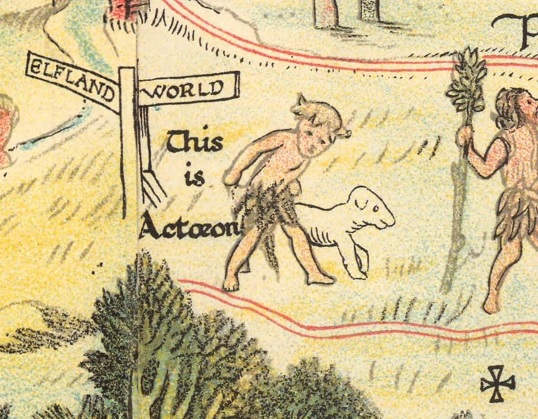
For example, there is one drawn at the very entrance to the Fire World by the South Beacon. There is another drawn at the entrance to "Elfland World". Another is drawn at the entrance to the Holy Grail Mountain by Sir Anodos. Another drawn at the entrance to the Underworld (once you have passed Cerberus / The Hydra). Another two are drawn at both entry points of Neverland. Another by the "Laidley" worm (being at the edge of the Earth World - where one can ride the dragon from there to Neverland. This is also a location that leads to the center). Another is shown by the waterfall that leads from the Water World and into the Earth World - and then one is shown at an entrance into the Earth World forest.
Strangely there is none at the far entrance to the Earth World by the North Beacon (although perhaps it is veiled in darkness, as much of that realm usually is). The Faerie Shrines appear to be portals of some sort - representing a shift in energy or place.
Going back to the story of Actaeon - we read of him out hunting for stags, when stumbling upon Diana and her nymphs while they are naked and bathing. Normally a huntress, she does not have her arrows on her - so she splashes water at his eyes and immediately a pair of stag horns begins to grow out of his head and he transforms into stag form and begins to run in terror. Then his own hounds who he had been hunting with - spot him, and not knowing the stag to be their own master begin to chase him endlessly until overtaking him and devouring him. Thus the Hunter became the Hunted and Actaeon is killed by his hounds.
This clearly identifies Actaeon with a Horned God-like figure, whose themes are very similar. And is not Jesus a similar symbol? Perhaps "The Vision of Saint Eustace" also tapped into some of these possibilities. Eventually in each of these cases they are of course resurrected. The Stag Horns are a great symbol for this because they are known to shed their horns and then regrow them - being a symbol of shedding, death, rebirth, and renewal.

It is also worth considering what Hugh Mynne writes here:
More of this can be understood in listening to Kate Bush's beautiful song: "Hounds of Love"...
Right next to Actaeon are the "Satyr" beings who are part man and part goat. They are often symbolized as quite beast-like and as "horny" symbols, depicted frequently with erections. They have been known to try and seduce or rape the nymphs. Diana on the other hand is a symbol of complete chastity and virginity - and so we are seeing these two extremes meet.
Pan is not unlike a satyr in his appearance with his lower half as a goat and upper as a man with horns. He is said to be the son of Hermes.
In the Fire Realms, Hermes took on a much more rustic form not unlike a satyr (pronounced quite similar to "Satan"), and I described my first encounters with him as wearing a winged helmet but covering his "two ram-like curly horns". Later once we entered into the Air World he took on a much more youthful appearance with either much smaller horns or none being visible at all. But I describe him in the Fire Realms as being in very "shepherd/rustic-like form, out in the sun on an island with the long country grass and with rams horns on his head."
It would not surprise me if he was being represented in this form on the Map of Faerieland where I have circled in red below:



Book #18. Chapter XXXII. Palinurus and Chapter XXXII. The Infernal Regions - The Sibyl
The Sibyl is clearly depicted here next to the symbolism of flames and before the bridge into Elfland/Faerieland or the Air World.

It is recommended to read the full chapter, but I shall provide excerpts of particular interest:
These then travel into the underworld and infernal regions - which is very different to what occurs between the Fire and Air Realms (rather these descriptions are better suited for the location on the map beneath the Holy Grail mountains - the entry being near to Cerberus and the Hydra). But the symbolism is very fit for the borders between the Fire and Air Realms - due to the representation of taking the boat to reach the island, then receiving permission (in our case from Hermes), sometimes paying a toll too (a "mortal kiss or two", as Sleigh puts it) before moving into guarded regions.
Highly likely that there may be infernal pathways in those darker regions through which to access Faerieland too.